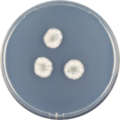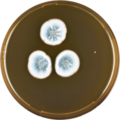| Aspergillus brevijanus | |
|---|---|
| Scientific classification | |
| Kingdom: | Fungi |
| Division: | Ascomycota |
| Class: | Eurotiomycetes |
| Order: | Eurotiales |
| Family: | Aspergillaceae |
| Genus: | Aspergillus |
| Species: | A. brevijanus |
| Binomial name | |
| Aspergillus brevijanus S.W. Peterson (2008) [1] | |
Aspergillus brevijanus is a species of fungus in the genus Aspergillus . It is from the Jani section. [2] The section only contains the two species A. brevijanus and A. janus. The colonies of the members of the section have both white and green sections. [2] The species was first described in 2008. [1]
In 2016, the genome of A. brevijanus was sequenced as a part of the Aspergillus whole-genome sequencing project - a project dedicated to performing whole-genome sequencing of all members of the genus Aspergillus. [3] The genome assembly size was 36.00 Mbp. [3]

